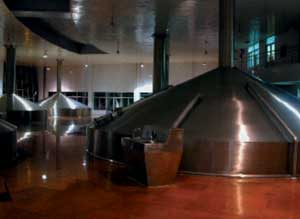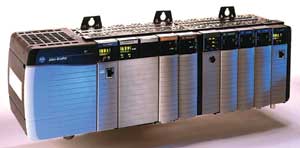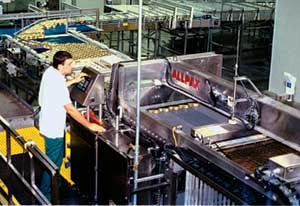TechnologyUpdate: Standards lead the way to flexible


“Essentially,” says Paul Moylan, product manager for Rockwell Automation, “flexible batch processing is the ability to produce the widest possible array of products with the most efficient possible use of process equipment.”
That’s where flexible batch processing capabilities can make a big difference for manufacturers. “With the continual fight for shelf space and the specialization of product lines to smaller markets,” says Dennis Brandl, president of BR&L Consulting, “a flexible batch processing system allows you to expand your product lines and still run efficient operations, even for small batch sizes.”
John Blanchard, principal analyst for ARC Advisory Group, points out that flexible batch processing also provides the ability to produce the same product but with different equipment. This allows a manufacturer to respond quickly to changes in forecasts or consumer demand by allowing a particular product to be made at
different manufacturing facilities. According to Blanchard, this flexibility
comes from its hierarchical recipe structure and the separation of recipe procedures
from equipment modules. “It [flexible batch processing] is not so much
about technologies as it is about methodologies,” he says.

Standards and technologies
PC-based systems provide the familiar foundation to readily gather, organize, analyze, and share the large amount of information that is necessary to fully realize the benefits of flexible batch processing. “One element that has made flexible batch easier to install has been PC-based recipe execution systems,” says Brandl. “These systems automatically control equipment, present instructions to operators, and collect execution data without human intervention. This results in more repeatable batches and improved data collection.” The Internet is having a significant impact on batch manufacturing, just like it is throughout all of manufacturing. The main contribution is to allow the sharing of data both internally and externally. According to Teddy H. Tom, product manager for batch applications at Siemens Energy and Automation, “It provides batch manufacturers with the ability to share batch processing data with others.” This includes those within their organization, their vendors, and their clients. The information passed may be used to schedule production, order materials, inform clients of deliver date, document batch production, or even enable vendors to access the process to analyze processing issues.However, the biggest impact on the ability to readily implement flexible batch processing can be attributed to the progress made with standards such as ISA S88 and ISA S95. Two of the key results stemming from S88 are the ability to separate recipe procedures from equipment control, and the modularization of batch procedures, equipment, and recipes.
According to Moylan, “Although flexible batch systems were possible prior to or in the absence of S88, the modularity and resulting methodologies provide a simpler approach to ensuring flexible batch processing.” Possible, yes, but now, says Blanchard, “the S88 batch standard is becoming a required standard for all current and future process automation systems.”
ISA S88.01, released in 1995, covers batch models and terminology. S88.02, released last year, deals with data structures and guidelines for languages. S88.03 is in development and will focus on general and site recipes. These three standards, individually and combined, provide the critical basis for the organization of batch systems, along with communications between and among suppliers and end users.
ISA S95 takes standardization up a notch in the enterprise and is designed to link manufacturing systems with business systems. This, says Blanchard, will provide the capability to improve manufacturing responsiveness to business planning. S95 is applicable to all manufacturing sectors, but it’s sure to have a significant impact in flexible batch processing because of the dynamic and fluid interaction of information that makes flexible batch processing what it is.
A number of food and beverage companies have already applied ISA S95 to tie their production into their global supply chains, notes Brandl. It has allowed them to reduce errors and delays in getting schedule information to production and actual production information to inventory. Brandl has seen some companies reduce their end-product inventory by more than 80% and one beverage company that reduced its inventory from three days to one day, eliminating entire warehouses.
One further standard that is poised to make its contribution in batch manufacturing has is roots in Internet technologies. XML (extensible markup language) is doing for data what HTML did for text. It provides a standard way to access, format, and exchange data between remote applications.
The World Batch Forum has developed two sets of XML derivatives that are specifically designed for batch operations. Its S88-based markup language—called the Batch Markup Language (BatchML)—allows companies to standardize and simplify the design of recipes and control systems in multi-system environments. The WBF S95-based markup language—called the Business to Manufacturing Markup Language (B2BMML)—offers a standard way for ERP and supply chain management systems to exchange information with manufacturing executions systems, laboratory information systems, and control systems.
At the World Batch Forum conference held in April, Invensys demonstrated the
application of this standard by exchanging production scheduling and performance
information between the Baan Protean Process ERP application and Foxboro’s
I/A Series batch application. Both of these applications were able to exchange
data by using XML documents that followed the WBF B2MML standard.

Implementation and pitfalls
The implementation of a flexible batch operation lends itself well to a staged approach. As a matter of fact, a staged implementation could be the best way to go. Tom says that it may be easier to implement flexible batch operating concepts into an existing operation. “In this scenario, the user already knows what equipment will be available, the capabilities of the equipment, the physical connections between the equipment that are possible, and the products that will be produced using this set of equipment. With this information, the user can, in stages, create, test, and store the recipe building blocks required by a flexible batch process. This can be done over a period of time on a unit-by-unit basis.”Flexible batch operation lends itself well to a staged implementation, in part, because of the nature of the flexible batch processing approach itself. As mentioned earlier, two key elements of flexible batch processing are the modularization of procedures, equipment, and recipes and the separation of recipes from equipment.
There are several key areas to focus on to properly implement a flexible batch processing operation. According to Brandl, one of the hardest parts of a flexible batch operation is changing the existing mindset that relates products to equipment. The focus must be on defining the equipment through its basic processing capabilities, independent of specific products. “It is easy to design a system that’s not flexible and does not allow multiple products without reprogramming or reconfiguration.” Stated another way by Tom, “The key point to remember,” he says, “is that the recipe building blocks used in flexible batch processing are equipment dependent and recipe independent. Each recipe building block represents a process action that can be carried out in a stated equipment entity.”
Beyond the relatively tangible issues of equipment and procedures and recipes, there may be broader organizational issues that need to be considered. Flexible batch processing allows a manufacturing enterprise to be agile, and quickly respond to the marketplace and the needs of its customers.Scott Williams, director of business development for Allpax Products Co., raises this very interesting point. “I believe the greatest pitfall to be faced is the changing of the corporate culture. A positive attitude and clear understanding by the workforce at every level is the cornerstone for success.” Flexible batch processing, says Williams, forces an organization to reach out and embrace changes on many levels. “From daily production schedules and on-line logistics management, to real-time manpower utilization, all facets of the business are put under the microscope for evaluation, criticism, and fine-tuning to operate in a dynamically changing production environment.”
The operational benefits, says Williams, include the ability to optimize all aspects of production (formulation, batch size, cycle time, quality, and cost) specific not only to each product, but also by package size and design, to precisely fill sales order backlog without building warehouse inventory
Implementing flexible batch processing methods has much upside potential and can transform a stagnant batch manufacturing enterprise into a state-of-the-art operation. The basics can be done without major capital expenditures and can be done in small pieces. Once established, additional automation can be added to further improve operating efficiencies.
For more information:
Robert Babecki, Invensys, 508-549-2076, rbabecki@foxboro.com
John Blanchard, ARC Advisory Group, 781-471-1169, jblanchard@arcweb.com
Dennis Brandl, BR&L Consulting, 919-852-5332, dnbrandl@bellsouth.net
Bert Dallas, Emerson Process Automation, 512-834-7078, bert.dallas@emersonprocess.com
Paul Moy
lan, Rockwell Automation, 919-388-8395, pemoylan@software.rockwell.com
Teddy H.
Tom, Siemens Energy & Automation, 215-646-7400, ext. 2356
Scott Williams, Allpax Products, Inc., 414-893-9277, scottw@allpax.com
Looking for a reprint of this article?
From high-res PDFs to custom plaques, order your copy today!






